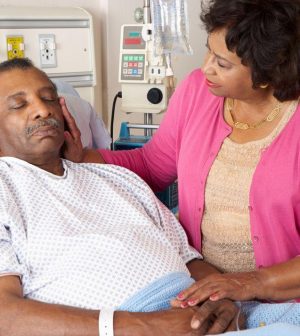- Navigating Your Midlife Crisis: Embracing New Possibilities
- City Raccoons Showing Signs of Domestication
- Mapping the Exposome: Science Broadens Focus to Environmental Disease Triggers
- One Week Less on Social Media Linked to Better Mental Health
- Your Brain Changes in Stages as You Age, Study Finds
- Some Suicide Victims Show No Typical Warning Signs, Study Finds
- ByHeart Formula Faces Lawsuits After Babies Sickened With Botulism
- Switch to Vegan Diet Could Cut Your Greenhouse Gas Emissions in Half
- Regular Bedtime Does Wonders for Blood Pressure
- Dining Alone Could Mean Worse Nutrition for Seniors
Report Highlights Big Gaps in Cancer Outcomes Based on Race

U.S. cancer death rates are continuing to drop, falling by 33% between 1991 and 2020.
However, not all Americans are reaping the benefits from advances in cancer prevention, early detection and treatment, a new report from the American Association for Cancer Research (AACR) shows.
Race, location and sexuality all play a role in cancer disparities across the United States, according to the AACR Cancer Disparities Progress Report 2024.
Black people and Native Americans continue to have the highest overall cancer death rates of all racial or ethnic groups, even though their overall cancer incidence rates are lower than those of whites, the report found.
Black Americans, in particular, have striking disparities in cancer deaths:
-
Black men are twice as likely to die from prostate cancer as white men.
-
Black women are 40% more likely to die from breast cancer as white women, even though they develop the cancer at similar rates.
-
Black people are twice as likely to be diagnosed with and die from multiple myeloma, a type of blood cancer.
Meanwhile, a number of groups — American Indian/Alaska Native, Asian/Pacific Islander and Hispanic people — are more than twice as likely to die from stomach cancer as whites. These groups also are more likely to develop and die from liver cancer.
A person’s zip code also plays a role in their cancer risk, the report found.
People in largely rural counties are 38% more likely to be diagnosed with and die from lung cancer, compared to those living in urban areas, researchers found.
Another source of disparity comes from a person’s sexual and gender orientation, the report shows:
-
The risk of breast cancer is higher among sexual minority women compared to heterosexual women
-
Transgender people have a 76% higher risk of being diagnosed with advanced-stage lung cancer compared to cisgender people
-
Transgender women are twice as likely to die from prostate cancer as cisgender men, even though they have a 60% lower risk of developing it
“The findings of this report offer a deeper dive into the ‘whole person’ as it relates to the areas outside of medicine that contribute to health inequities,” said Dr. Robert Winn, chair of the AACR steering committee that produced the report.
“We have seen tremendous progress against cancer in the last few decades, but we must keep fighting to ensure equal access and improved health care delivery for all people,” added Winn, who is director of the Virginia Commonwealth University Massey Comprehensive Cancer Center.
Potential roots of these observed inequities could include, according to the report:
-
Social drivers of health like education level, income, employment, housing, transportation and access to health care and good food. Residents of disadvantaged neighborhoods have a 22% higher death rate for all cancers combined, the report noted
-
Differences in biological factors like genetics, immune profiles and gut bacteria
-
A lack of cancer genetics research involving a broad diversity of races
-
A lack of diversity among people in health care and cancer research
However, some progress has been made in narrowing these disparities, the report added.
The disparity in the overall cancer death rate between Black people and whites has narrowed significantly over the past three decades, from 33% in 1990 to just over 11% in 2020.
Specifically, disparities have narrowed for:
-
Lung cancer between white and Black men.
-
Cervical cancer between white and Hispanic women.
-
Stomach cancer between white and Asian/Pacific Islander populations.
The AACR report calls for billions in federal funding to fight these disparities, including more than $51 billion for the National Institutes of Health and nearly $8 billion for the National Cancer Institute in 2025.
The AACR also urged $472 million in funding for a U.S. Centers for Disease Control and Prevention program aimed at health equity, as well as continued funding for Cancer Moonshot activities.
“In this era of extraordinary scientific progress against cancer, it is crucial that we ensure that no populations or communities are left behind. Health equity is a fundamental human right and must be a national priority,” said Dr. Margaret Foti, chief executive officer of the AACR.
“We hope that the information and recommendations in this report will inspire collaboration among stakeholders and the necessary support from Congress to tackle these complex issues and eliminate cancer disparities once and for all,” Foti added in an AACR news release.
More information
The National Cancer Institute has more on cancer disparities.
SOURCE: American Association for Cancer Research, news release, May 15, 2024
Source: HealthDay
Copyright © 2025 HealthDay. All rights reserved.










